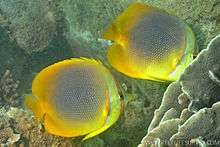Chaetodon aureofasciatus
The Golden Butterflyfish / Gold Stripe Butterflyfish (Chaetodon aureofasciatus)
| Golden butterflyfish | |
|---|---|
 | |
| Scientific classification | |
| Kingdom: | |
| Phylum: | |
| Class: | |
| Order: | |
| Family: | |
| Genus: | |
| Subgenus: | Discochaetodon |
| Species: | C. aureofasciatus |
| Binomial name | |
| Chaetodon aureofasciatus Macleay, 1878 | |
This butterflyfish is often mistaken for an angelfish because of the similar physical appearance. The Chaetodon aureofasciatus has an ovular, disk-like body that resembles the angelfish, but its biological morphology tethers it to the Chaetodontidae family. The Golden butterflyfish has a distinct coloration -- the central point of this fish is a light blue, but this fades into a gradient of a vivid yellow as it fans out. Additionally, there are several stripes that uniquely balance white and orange (typically around the eye) as seen below. These are relatively small coral-feeding fish, usually around 5 inches (1).
Morphology
As stated earlier, this species is commonly mistaken for a member of the angelfish family. However, the Chaetodon aureofasciatus has a fairly complicated morphology in regards to its species. However, advances in modern technology has allowed for a more precise classification of the Golden butterflyfish. Dr. Tim Littlewood, a prominent figure in LCNDTR and avid researcher, completed an extensive phylogenetic tree alongside his team in 2004. This noted a multitude of species within the butterflyfish family (2). Littlewood and his team marked several notable discoveries within this study, especially in regards to broad relationships. It was stated that the genus that is most similar to Chaetodon is the Prognathodes, and through very close evolution there has been the presence of hybridizations between these ‘sister subgenuses.’ In fact, Chaetodon aureofasciatus is one of the species that is known to be the spawn of this hybridization (2).
Habitat
Commonly referred to as the Golden butterflyfish, this species was discovered in 1878 by and named by Macleay. This ray-finned fish inhabits shallow areas in the pan-tropical region of the ocean, most commonly distributed in the Western Pacific. This includes the perimeter of Northwest Australia and the Great Barrier Reef, even into the shores of Papua New Guinea (1). They are associated with reefs, as they are a part of the butterflyfish (Chaetodontidae) family. They are non-migratory fish, unlike other individuals of Chaetodontidae that change habitat based on life stages (3). Thus, the Golden butterflyfish continually dwells at a relatively shallow depth --typically spotted at a range of 5 - 15 meters (3).
Habitat Threats
There have been many concerns about the habitat of this species, especially as circumstances surrounding coral reefs grow more dire. Increasing temperatures and subsequent bleaching of the reefs concern scientists. The Chaetodon aureofasciatus feeds on live coral, which makes these fish particularly susceptible to habitat destruction. Morgan Pratchett (PhD Marine ecology) noted that coral degradation will have severe effects on the abundances of coral-feeding species back in 2006 (4). Since then, the Pacific coral habitat of the Golden butterflyfish has been significantly depleted due to a combination of rising temperatures, ocean acidification, pollution, etc. This concern was raised over a decade ago --yet, the steepest decline in equatorial coral reefs were seen more recently (5).
Behavior
Some species within the butterflyfish bracket migrate location depending on their life stage --as juveniles they display a selective inclination to shallow habitats with low wave impact. These species include Chaetodon auriga, Chaetodon melannotus and Chaetodon vagabundus (4). This mechanism of migration has significance for an array of reasons. For one, this aids in avoiding predation in juveniles. Golden butterflyfish, however, do not display this behavior. This species has, in fact, shown behavioral changes that contradict its historical niche. As a spawn of coral-feeding fish, the Chaetodon aureofasciatus should hover within a certain distance of coral reefs. Yet, it was found that this species displays a high tolerance to brackish water --as the species was found near river mouths. This means that the Golden butterflyfish can withstand a relatively wide range of salinity (6).
Diet
In a different study performed by Dr. Pratchett, it was determined that the Golden butterflyfish does not depend solely on scleractinian (stony corals) for food. The Chaetodon aureofasciatus has a more diverse diet compared to other members of the butterflyfish family that do depend on specific corals for their diet (4). It is known from observers in Australia that these primarily fish feed on coral polyps, which is becoming increasingly threatened (7). It can be inferred that their diet is becoming diversified due to coral reef decline, hence why there are increasing sightings of this species in brackish water.
References
- Pyle, R., Myers, R., Craig, M.T. & Pratchett, M., 2010. aureofasciatus. In: IUCN 2013. IUCN Red List of Threatened Species. Version 2013.1. <www.iucnredlist.org>. Downloaded on 27 April 2017.
1 - Luna, Susan M, and Kristine Olisa. “Chaetodon Aureofasciatus - Summary Page.” World Wide Web electronic publication. www.fishbase.org. (2019). www.fishbase.se/summary/6513
2 - Littlewood, D.T.J. & McDonald, Sarah & Gill, Anthony & Cribb, Thomas. (2004). Molecular phylogenetics of Chaetodon and the Chaetodontidae (Teleostei : Perciformes) with reference to morphology. Zootaxa. 779.
3 - Lieske, E. and R. Myers, 1994. Collins Pocket Guide. Coral reef fishes. Indo-Pacific & Caribbean including the Red Sea. Harpercollins Publishers, 400 p.
4 - Pratchett, M.S., Wilson, S.K. and Baird, A.H. (2006), Declines in the abundance of Chaetodon butterflyfishes following extensive coral depletion. Journal of Fish Biology, 69: 1269-1280. doi:10.1111/j.1095-8649.2006.01161.
5 - Cho, Renee, et al. “Losing Our Coral Reefs.” State of the Planet, 9 Dec. 2019, blogs.ei.columbia.edu/2011/06/13/losing-our-coral-reefs/.
6 - Atlas of Living Australia occurrence download at http://www.ala.org.au. Accessed 11 April 2020.
7. Dianne J. Bray & Audrey S. Thompson, Chaetodon aureofasciatus in Fishes of Australia, accessed 12 Apr 2020, http://136.154.202.208/home/species/2374
